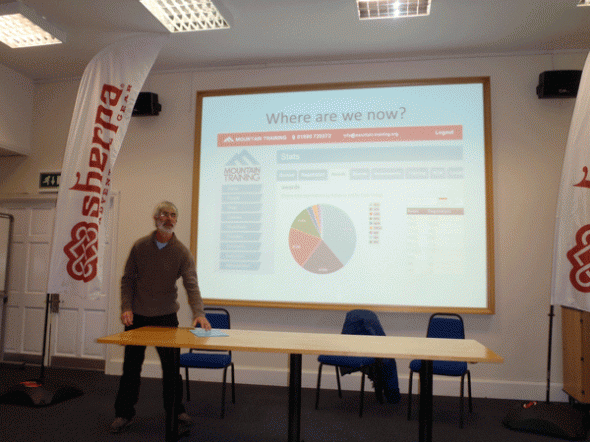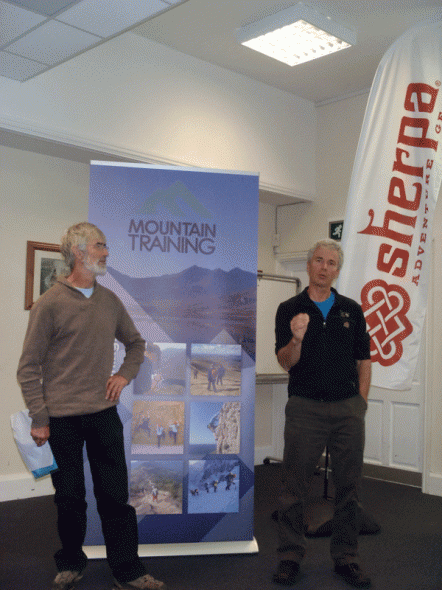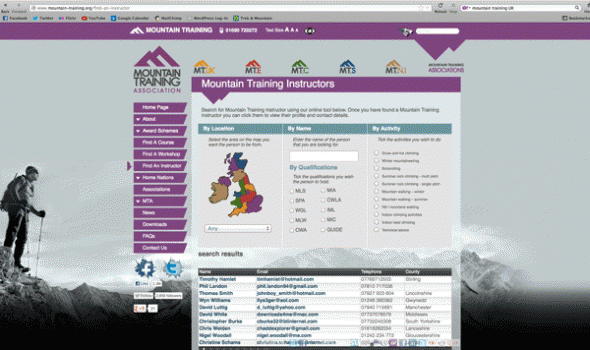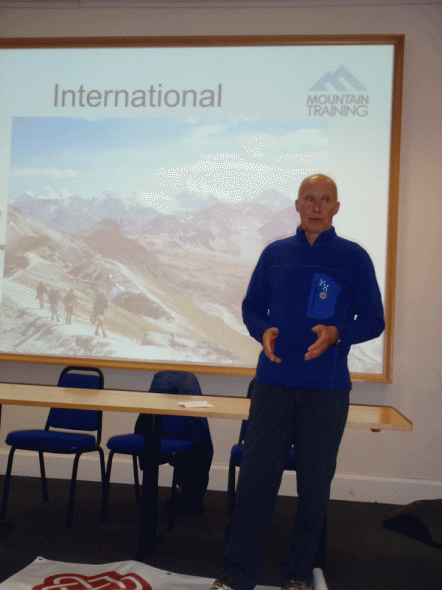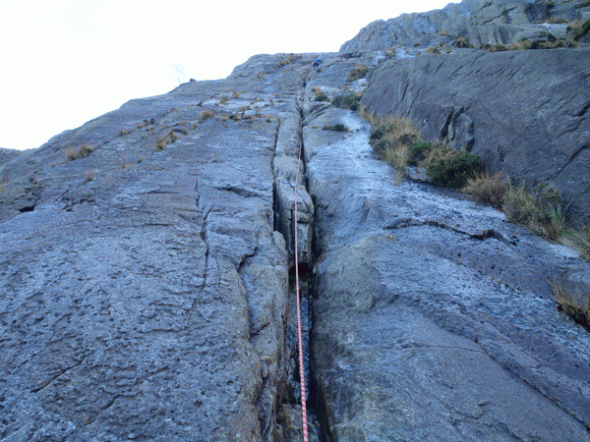Welcome to my first Editor’s Blog, in which I’ll be writing about some of the outdoor events, gatherings and industry days I attend as part of my job as Trek & Mountain Editor/Publisher – and also some of the stuff from hill days, treks and expeditions I go on that I can’t find space for in the magazine. Hopefully you’ll find at least some of it interesting!
This first blog is about a two-day ‘press briefing’ I attended, held by Mountain Training UK at The National Mountain Centre, Plas y Brenin, on 18-19th October. The invitation email gave little indication as to what it was all about, but what I did glean was that it was being hosted by Mountain Training UK Chairman (and Rab equipment founder) Rab Carrington, and that the event would also include talks by Alan Hinkes and Kenton Cool, and a coaching session at the PYB climbing wall with Neil Gresham. With such an illustrious rollcall of names, I decided I couldn’t pass this by, so I set off on the five-hour journey to North Wales with my curiosity more than a little piqued.
Arriving at PYB just in time for some lunch in the canteen, I was introduced to the Mountain Training team (some of whom have previously contributed to the magazine such as Mal Creasey and Martin Chester) and said hellos to other journalists, Jon Garside and Tom Hutton from the BMC, and high altitude legend Alan Hinkes (also a contributor to Trek & Mountain) who had come along for both days. Then it was into the lecture hall to find out why we had been summoned to Capel Curig!
The first announcement was that the actual name of Mountain Leader Training had changed, to just ‘Mountain Training’. The traditional awards such as Mountain Leader (summer and winter), Mountaineering Instructor’s Award, Mountaineering Instructor’s Certificate and so on, have in more recent times been added to by things like the Single Pitch Award (SPA) and Climbing Wall Instructor’s certificate to reflect the popularity of climbing walls. The sport of mountaineering has always involved a ‘rainbow’ of skills and knowledge, and the awards have evolved over the years to reflect this – and now the name of the training organisation has evolved too. Makes perfect sense!
The next announcement was concerning a new online system called the Candidate Management System (or just CMS) which logs all the relevant information about existing mountain professionals and also those currently in training. As well as saving loads of administration for MT, it means that everyone involved in training can check or update their details in real-time, and also check the details of others. Not only that, but the system can also be used by the public as a searchable database for finding a Mountain Leader, Guide or other professional to take them out on the hill. So say you want to find someone in North Wales to take you out for a day’s scrambling or climbing, you just select the region and the activity and the tool will give you a list of names of suitably qualified professionals that operate in your chosen area. You can try out the tool for yourself at www.mountain-training.org/find-an-instructor
The final ‘strand’ of announcements concerned aspirations for the future, and in particular the introduction of coaching standards to the mountain training structure, inspired partly by the success that other sports, such as cycling and rowing, have enjoyed as a direct result of top-notch coaching. Although this seems to be a long-term project, steps have already been taken to study how mountaineering can learn from other sports in this area. And to demonstrate what was meant by coaching – as opposed to instruction – we all headed off to the climbing wall where Neil Gresham treated the climbers in the group to a half-hour coaching session. During the session, Neil covered a number of things, including how to place our feet precisely, slowly and ‘quietly’ on holds, how to climb overhangs by crossing feet over, and how to climb with straight arms thus reducing the effort on the muscles/tendons. All brilliant stuff that you wouldn’t necessarily learn down your local climbing wall.
With the serious messages of the day over, it was time for some entertainment, first in the shape of Alan Hinkes and followed up by Kenton Cool. The styles of the two high-altitude heroes couldn’t have been more different – Alan making light of some of the life-and-death situations he’s been in during his 8000m peaks challenge, and generally speaking his mind as only a Yorkshireman can! Cool, on the other hand, had a more studious – though no less entertaining – approach, taking us back to the early expeditions to Everest, and linking them in neatly with his own recent exped to ‘fulfil the pledge’ to take one of the Olympic gold medals awarded to the 1922 British Everest Expedition members to the summit, in the year of the London Olympics. If you get a chance to go and see either Alan and Kenton talk, do go – you won’t be disappointed.
After these two excellent talks, it was straight to the PYB bar for a few beers, and then off to bed. The next day we headed into the hills – after all, you can’t come to North Wales and not do at least some walking or climbing, can you? We split into two groups, with Alan and Kenton heading off with the larger group, while myself and Tom Hutton set out for the Idwal Slabs, where we had a couple of hours of enjoyable – if wet – climbing. Thanks for leading Tom.
So what had we learned over the two days? That the Mountain Training organisation (or organisations, as there are separate bodies for England, Wales, Scotland and Northern Ireland which work together under the umbrella of MTUK) is definitely not sitting back on its laurels, that it is moving with the times in terms of systems (CMS) and awards (climbing walls), that is learning from the successes of other sports, and is fighting the corner of the sport in terms of recognition (and funding) from the Government. And having met, and listened to, the leading figures in Mountain Training over two days, I’m confident that there’s the passion and drive to make sure the organisation keeps evolving and innovating in the years ahead.
Before I finish, a question for you: What’s the difference between a Mountain Leader, International Mountain Leader, Mountain Guide, Mountaineering Instructor Certificate (MIC) holder, and Mountaineering Instructor Award (MIA) holder? If you don’t know then check out the websites below… For those that do know, here’s another question for you: What’s the difference between God and a Mountain Guide? Answers on a postcard…!
RELATED LINKS
www.mountain-training.org
www.ami.org.uk
www.bmg.org.uk
www.baiml.org


